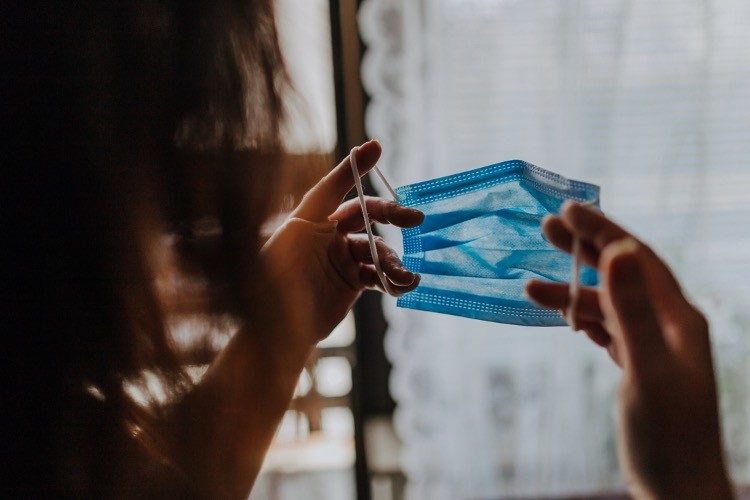
To mask or not to mask? Do we dare ask? Wearing a face mask in response to COVID-19 is often mandated by government and has become socially expected in many situations. California lawmakers have gone so far as to dictate that people “must wear face coverings when they are outside of the home” — period.
Contrary opinions about these rules or the safety of widespread masking are largely ignored by government and mainstream media and censored by social media. Yet there may be a reason why Democratic California politicians, such as Governor Gavin Newsom, House Speaker Nancy Pelosi, and Senator Diane Feinstein, have been caught unmasked in public in violation of the regulations they themselves advocate.
Solid research has shown that there’s no evidence face masks, when prescribed for the general population (and worn by healthy individuals), offer protection from the coronavirus.
In this vein, Sweden’s chief epidemiologist, Anders Tegnell, warned last year that mask wearing was dangerous because it lends a false sense of security. Moreover, ex-Army surgical technician and biologist J.H. Capron, also suggested in 2020 that masks may be contributing to the spread of SARS-CoV-2, harboring germs and bacteria like facial Petri dishes. But now it’s theorized that they may pose a chemical threat as well.
The American Institute for Economic Research (AIER) reports on
[the] potential danger of the chlorine, polyester, and microplastic components of the face masks (surgical principally but any of the mass-produced masks) that have become part of our daily lives due to the Covid-19 pandemic.
… Emergent reports, albeit nascent and anecdotal but nevertheless vitally important (and will be clarified and defined in time) regarding the manufacture of masks, where, “many of them (face masks) are made of polyester, so you have a microplastic problem … many of the face masks would contain polyester with chlorine compounds.… If I have the mask in front of my face, then of course I inhale the microplastic directly and these substances are much more toxic than if you swallow them, as they get directly into the nervous system.”
There are also reports of toxic mould, fungi, and bacteria that can pose a significant threat to the immune system by potentially weakening it. Of particular concern to us is the recent report of breathing in synthetic fibers in the face masks. This is of serious concern. “Loose particulate was seen on each type of mask. Also, tight and loose fibers were seen on each type of mask. If every foreign particle and every fiber in every facemask is always secure and not detachable by airflow, then there should be no risk of inhalation of such particles and fibers. However, if even a small portion of mask fibers is detachable by inspiratory airflow, or if there is debris in mask manufacture or packaging or handling, then there is the possibility of not only entry of foreign material to the airways, but also entry to deep lung tissue, and potential pathological consequences of foreign bodies in the lungs.”
Reports are that “Graphene is a strong, very thin material that is used in fabrication, but it can be harmful to lungs when inhaled and can cause long-term health problems.” We argue that there is a risk of potential “future” inflammatory/fibrotic lung diseases because we are inhaling these materials in the masks now for over one year with more duration to come and no end in sight. These substances might also be highly carcinogenic.
The AIER also relates that “Health Canada has issued a warning about blue and gray disposable face masks, which contain an asbestos-like substance associated with ‘early pulmonary toxicity.’” There’s more in the long AIER report, too.
To be clear, it’s difficult to say how valid these concerns are. Obviously, just as people advocating mask use (the Establishment stance) will trumpet information buttressing their position, those opposed will promote information advancing theirs.
Yet common sense informs that something unnatural, such as wearing a mask for hours a day, that offers little or no benefit should be avoided. And keeping your mouth and nose covered with a close-fitting mask to protect from a highly treatable virus is certainly unnatural. So the question is: Do masks offer benefits?
“The truth is there is no scientific evidence affirming the value of face coverings in preventing the transmission of viruses,” wrote physician and ex-congressional candidate Dr. James Veltmeyer last year. “Recent studies have been unable to establish any conclusive relationship between mask/respirator use and protection against influenza infection, according to nationally recognized neurosurgeon Dr. Russell Blaylock.”
“While it’s too early to report any studies related to COVID-19, it’s unlikely masks would be any more effective against it than against the flu virus,” Veltmeyer continued. “Surgeon General Dr. Jerome Adams himself said in March that: ‘The data doesn’t show that wearing masks in public will help people during the coronavirus pandemic.’”
Veltmeyer and Adams are far from alone in their conclusions. Moreover, a greatly overlooked factor here that must be considered in all things is theoretical vs. practical application.
We shouldn’t simply ask how effective the masking prescription is if a theoretical person (responsible) wears a theoretical mask (N95) maintained and worn in a theoretical way (disinfected and properly fitted), but how will the general population apply the recommendation? For many, the mask has become an ill-fitting facial Petri dish.
We should also consider the long-term psychological/social effects of mask wearing, especially on our children.
While everyone has to make his own health decisions — as he’ll enjoy the benefits or suffer the consequences thereof — I don’t believe the risk/reward factor militates in favor of wearing masks. The claimed upsides are unconvincing, and the possible downsides are frightening.
Mask-wearing has become part of COVID Ritual, and our collective version of Linus’s security blanket. The difference is that Linus merely carried his blanket; he didn’t wrap it around his face and inhale it.




